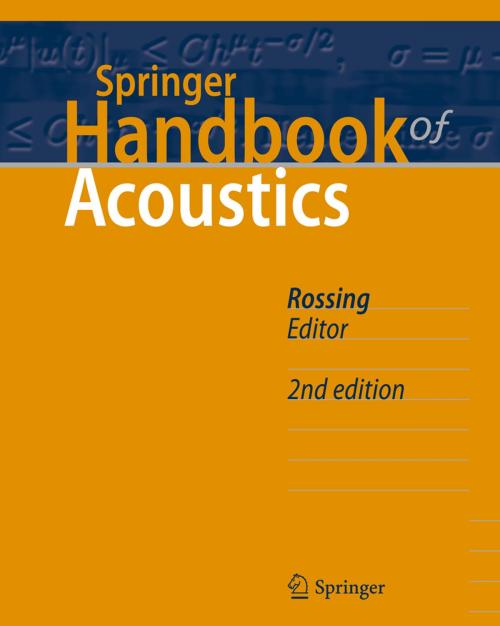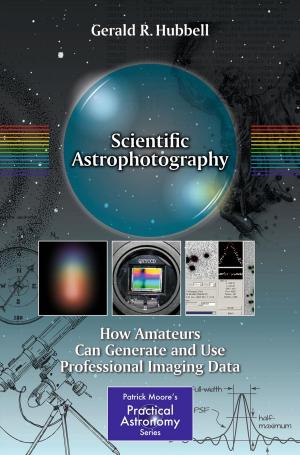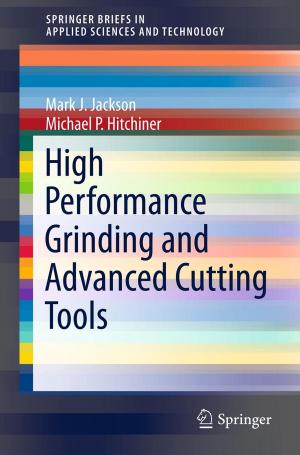Springer Handbook of Acoustics
Nonfiction, Science & Nature, Science, Physics, Acoustics & Sound, Biological Sciences, Zoology| Author: | W.M. Hartmann, F. Dunn, D.M. Campbell, N.H. Fletcher | ISBN: | 9781493907557 |
| Publisher: | Springer New York | Publication: | January 15, 2015 |
| Imprint: | Springer | Language: | English |
| Author: | W.M. Hartmann, F. Dunn, D.M. Campbell, N.H. Fletcher |
| ISBN: | 9781493907557 |
| Publisher: | Springer New York |
| Publication: | January 15, 2015 |
| Imprint: | Springer |
| Language: | English |
Acoustics, the science of sound, has developed into a broad interdisciplinary field encompassing the academic disciplines of physics, engineering, psychology, speech, audiology, music, architecture, physiology, neuroscience and others. Here is an unparalleled modern handbook reflecting this richly interdisciplinary nature edited by one of the acknowledged masters in the field, Thomas Rossing.
Researchers and students benefit from the comprehensive contents spanning: animal acoustics including infrasound and ultrasound, environmental noise control, music and human speech and singing, physiological and psychological acoustics, architectural acoustics, physical and engineering acoustics, medical acoustics and ocean acoustics.
The Springer Handbook of Acoustics reviews the most important areas of acoustics, with emphasis on current research. The authors of the various chapters are all experts in their fields. Each chapter is richly illustrated with figures and tables. The latest research and applications are incorporated throughout, e.g. computer recognition and synthesis of speech, physiological acoustics, psychological acoustics, thermoacoustics, diagnostic imaging and therapeutic applications and acoustical oceanography.
This new edition of the Handbook features over 11 revised and expanded chapters, new illustrations and two new chapters covering microphone arrays, acoustic metamaterials and acoustic emission. These improvements will make the handbook even more useful as a reference and a guide for researchers and students in every branch of acoustics.
Praise for the first edition:
"This treatise is a successful attempt to cover in one book the diverse field of acoustics, which ranges from physics to music and from formal mathematics to technological applications. ... It is this reviewer's opinion that a handbook like Rossing's, which covers the whole field of acoustics, serves a real purpose because it not only gives one a chance to see how one's specialty is covered but it also permits one to make a quick survey of other acoustical areas." (Leo Beranek, American Journal of Physics, Vol. 77 (12), December, 2009)
"The Springer Handbook of Acoustics falls into that exceptional list. ...every physics department should have a copy available." (John L. Hubisz, The Physics Teacher, Vol. 48, March, 2010)
"This handbook is an excellent addition to the acoustics literature. ... The handbook nicely covers both basics and advances in several areas of acoustics. Several chapters provide good mathematical depth, making the handbook useful as a research and technical resource. ...Overall, a very useful educational and research resource. Summing Up: Recommended. Upper-division undergraduates through professionals." (M. G. Prasad, CHOICE, Vol. 45 (5), January, 2008)
"This book covers a wide range of topics and the inclusion of musical acoustics, computer and electronic music appeal to me (singer, song-writer, performer and recording studio co-owner). This handbook is probably well suited for an undergraduate-level introduction to an acoustics course. ... The wide range of topics, inclusion of music-related chapters, eye-pleasing presentations and other useful features make this a very good book to have on your shelf." (Tim Casey, International Journal of Acoustics and Vibration, Vol. 13 (1), 2008)
"The Springer Handbook of Acoustics comprises 28 chapters written by 33 authors. The Handbook of Acoustics is useful as a source book for anyone who needs or wants to become familiar with the jargon and issues related to a specific subfield of acoustics ... ." (Robert I. Odom, Siam Review, Vol. 50 (3), 2008)
The Springer Handbook of Acoustics reviews the most important areas of acoustics, with emphasis on current research. The authors of the various chapters are all experts in their fields. Each chapter is richly illustrated with figures and tables. The latest research and applications are incorporated throughout, e.g. computer recognition and synthesis of speech, physiological acoustics, psychological acoustics, thermoacoustics, diagnostic imaging and therapeutic applications and acoustical oceanography.
This new edition of the Handbook features over 13 revised and expanded chapters, new illustrations and 3 new chapters covering microphone arrays, acoustic metamaterials and acoustic emission. These improvements will make the handbook even more useful as a reference and a guide for researchers and students in every branch of acoustics.
Acoustics, the science of sound, has developed into a broad interdisciplinary field encompassing the academic disciplines of physics, engineering, psychology, speech, audiology, music, architecture, physiology, neuroscience and others. Here is an unparalleled modern handbook reflecting this richly interdisciplinary nature edited by one of the acknowledged masters in the field, Thomas Rossing.
Researchers and students benefit from the comprehensive contents spanning: animal acoustics including infrasound and ultrasound, environmental noise control, music and human speech and singing, physiological and psychological acoustics, architectural acoustics, physical and engineering acoustics, medical acoustics and ocean acoustics.
The Springer Handbook of Acoustics reviews the most important areas of acoustics, with emphasis on current research. The authors of the various chapters are all experts in their fields. Each chapter is richly illustrated with figures and tables. The latest research and applications are incorporated throughout, e.g. computer recognition and synthesis of speech, physiological acoustics, psychological acoustics, thermoacoustics, diagnostic imaging and therapeutic applications and acoustical oceanography.
This new edition of the Handbook features over 11 revised and expanded chapters, new illustrations and two new chapters covering microphone arrays, acoustic metamaterials and acoustic emission. These improvements will make the handbook even more useful as a reference and a guide for researchers and students in every branch of acoustics.
Praise for the first edition:
"This treatise is a successful attempt to cover in one book the diverse field of acoustics, which ranges from physics to music and from formal mathematics to technological applications. ... It is this reviewer's opinion that a handbook like Rossing's, which covers the whole field of acoustics, serves a real purpose because it not only gives one a chance to see how one's specialty is covered but it also permits one to make a quick survey of other acoustical areas." (Leo Beranek, American Journal of Physics, Vol. 77 (12), December, 2009)
"The Springer Handbook of Acoustics falls into that exceptional list. ...every physics department should have a copy available." (John L. Hubisz, The Physics Teacher, Vol. 48, March, 2010)
"This handbook is an excellent addition to the acoustics literature. ... The handbook nicely covers both basics and advances in several areas of acoustics. Several chapters provide good mathematical depth, making the handbook useful as a research and technical resource. ...Overall, a very useful educational and research resource. Summing Up: Recommended. Upper-division undergraduates through professionals." (M. G. Prasad, CHOICE, Vol. 45 (5), January, 2008)
"This book covers a wide range of topics and the inclusion of musical acoustics, computer and electronic music appeal to me (singer, song-writer, performer and recording studio co-owner). This handbook is probably well suited for an undergraduate-level introduction to an acoustics course. ... The wide range of topics, inclusion of music-related chapters, eye-pleasing presentations and other useful features make this a very good book to have on your shelf." (Tim Casey, International Journal of Acoustics and Vibration, Vol. 13 (1), 2008)
"The Springer Handbook of Acoustics comprises 28 chapters written by 33 authors. The Handbook of Acoustics is useful as a source book for anyone who needs or wants to become familiar with the jargon and issues related to a specific subfield of acoustics ... ." (Robert I. Odom, Siam Review, Vol. 50 (3), 2008)
The Springer Handbook of Acoustics reviews the most important areas of acoustics, with emphasis on current research. The authors of the various chapters are all experts in their fields. Each chapter is richly illustrated with figures and tables. The latest research and applications are incorporated throughout, e.g. computer recognition and synthesis of speech, physiological acoustics, psychological acoustics, thermoacoustics, diagnostic imaging and therapeutic applications and acoustical oceanography.
This new edition of the Handbook features over 13 revised and expanded chapters, new illustrations and 3 new chapters covering microphone arrays, acoustic metamaterials and acoustic emission. These improvements will make the handbook even more useful as a reference and a guide for researchers and students in every branch of acoustics.















